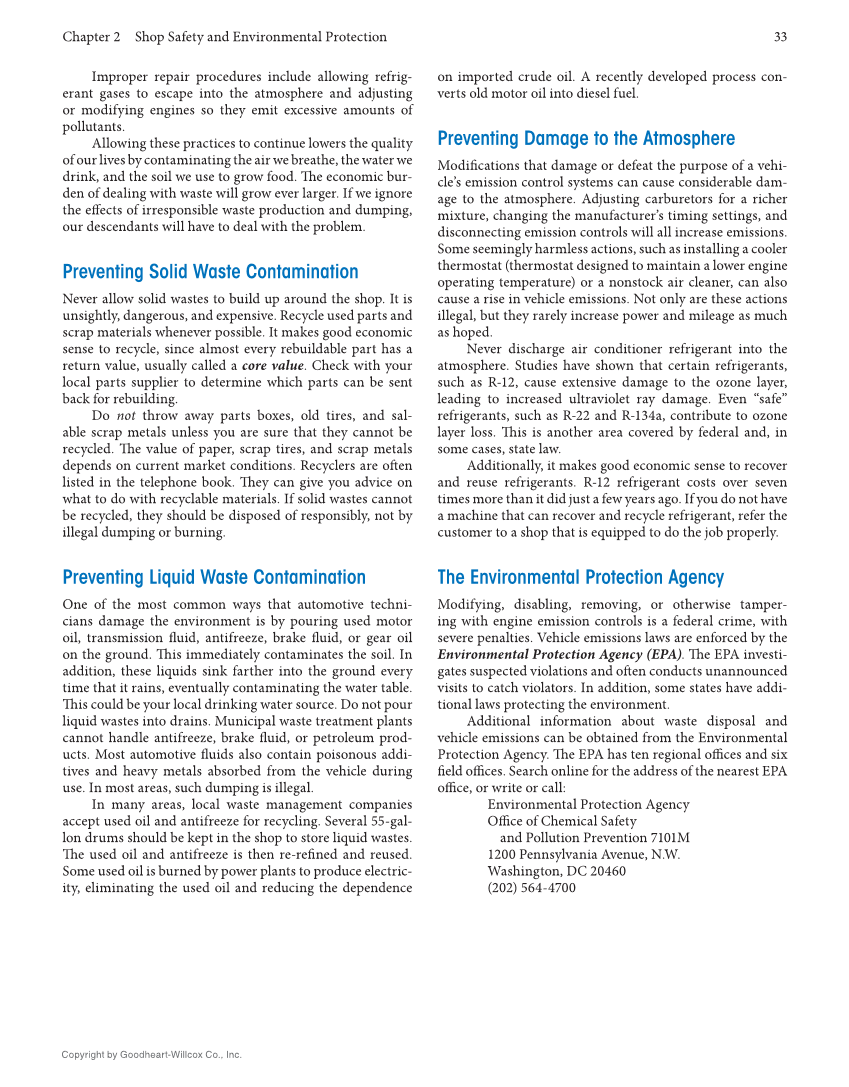Chapter 2 Shop Safety and Environmental Protection 33 Copyright by Goodheart-Willcox Co., Inc. Improper repair procedures include allowing refrig- erant gases to escape into the atmosphere and adjusting or modifying engines so they emit excessive amounts of pollutants. Allowing these practices to continue lowers the quality of our lives by contaminating the air we breathe, the water we drink, and the soil we use to grow food. Th e economic bur- den of dealing with waste will grow ever larger. If we ignore the eff ects of irresponsible waste production and dumping, our descendants will have to deal with the problem. Preventing Solid Waste Contamination Never allow solid wastes to build up around the shop. It is unsightly, dangerous, and expensive. Recycle used parts and scrap materials whenever possible. It makes good economic sense to recycle, since almost every rebuildable part has a return value, usually called a core value. Check with your local parts supplier to determine which parts can be sent back for rebuilding. Do not throw away parts boxes, old tires, and sal- able scrap metals unless you are sure that they cannot be recycled. Th e value of paper, scrap tires, and scrap metals depends on current market conditions. Recyclers are oft en listed in the telephone book. Th ey can give you advice on what to do with recyclable materials. If solid wastes cannot be recycled, they should be disposed of responsibly, not by illegal dumping or burning. Preventing Liquid Waste Contamination One of the most common ways that automotive techni- cians damage the environment is by pouring used motor oil, transmission fl uid, antifreeze, brake fl uid, or gear oil on the ground. Th is immediately contaminates the soil. In addition, these liquids sink farther into the ground every time that it rains, eventually contaminating the water table. Th is could be your local drinking water source. Do not pour liquid wastes into drains. Municipal waste treatment plants cannot handle antifreeze, brake fl uid, or petroleum prod- ucts. Most automotive fl uids also contain poisonous addi- tives and heavy metals absorbed from the vehicle during use. In most areas, such dumping is illegal. In many areas, local waste management companies accept used oil and antifreeze for recycling. Several 55-gal- lon drums should be kept in the shop to store liquid wastes. Th e used oil and antifreeze is then re-refi ned and reused. Some used oil is burned by power plants to produce electric- ity, eliminating the used oil and reducing the dependence on imported crude oil. A recently developed process con- verts old motor oil into diesel fuel. Preventing Damage to the Atmosphere Modifi cations that damage or defeat the purpose of a vehi- cle’s emission control systems can cause considerable dam- age to the atmosphere. Adjusting carburetors for a richer mixture, changing the manufacturer’s timing settings, and disconnecting emission controls will all increase emissions. Some seemingly harmless actions, such as installing a cooler thermostat (thermostat designed to maintain a lower engine operating temperature) or a nonstock air cleaner, can also cause a rise in vehicle emissions. Not only are these actions illegal, but they rarely increase power and mileage as much as hoped. Never discharge air conditioner refrigerant into the atmosphere. Studies have shown that certain refrigerants, such as R-12, cause extensive damage to the ozone layer, leading to increased ultraviolet ray damage. Even “safe” refrigerants, such as R-22 and R-134a, contribute to ozone layer loss. Th is is another area covered by federal and, in some cases, state law. Additionally, it makes good economic sense to recover and reuse refrigerants. R-12 refrigerant costs over seven times more than it did just a few years ago. If you do not have a machine that can recover and recycle refrigerant, refer the customer to a shop that is equipped to do the job properly. The Environmental Protection Agency Modifying, disabling, removing, or otherwise tamper- ing with engine emission controls is a federal crime, with severe penalties. Vehicle emissions laws are enforced by the Environmental Protection Agency (EPA). Th e EPA investi- gates suspected violations and oft en conducts unannounced visits to catch violators. In addition, some states have addi- tional laws protecting the environment. Additional information about waste disposal and vehicle emissions can be obtained from the Environmental Protection Agency. Th e EPA has ten regional offi ces and six fi eld offi ces. Search online for the address of the nearest EPA offi ce, or write or call: Environmental Protection Agency Offi ce of Chemical Safety and Pollution Prevention 7101M 1200 Pennsylvania Avenue, N.W. Washington, DC 20460 (202) 564-4700
